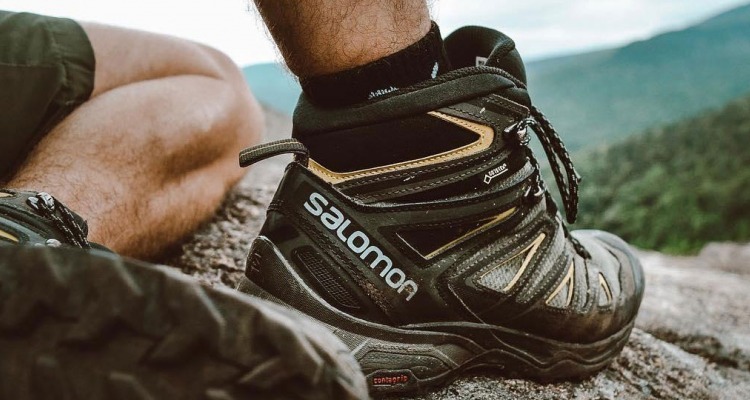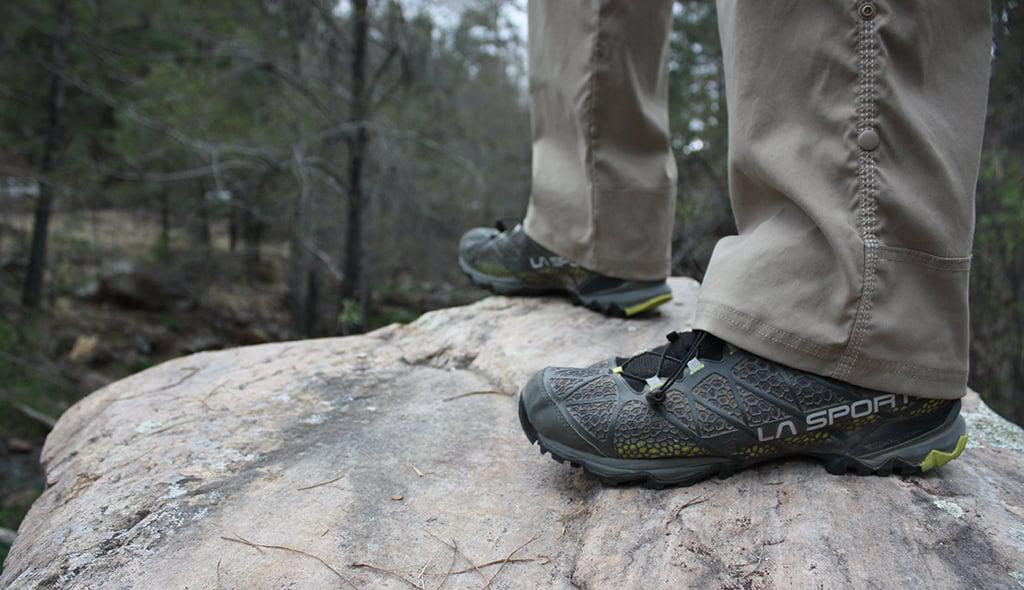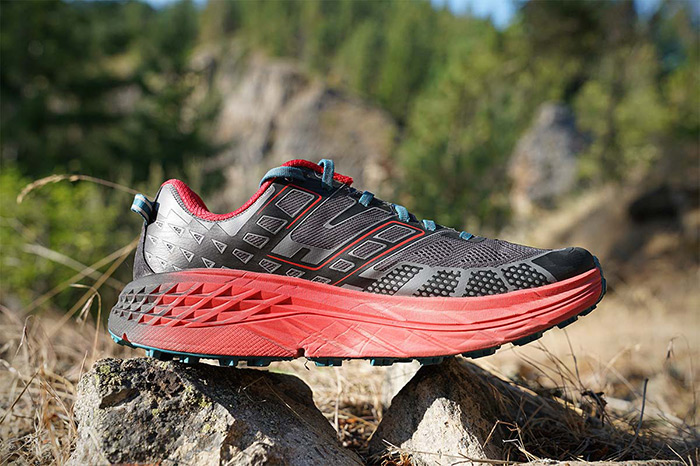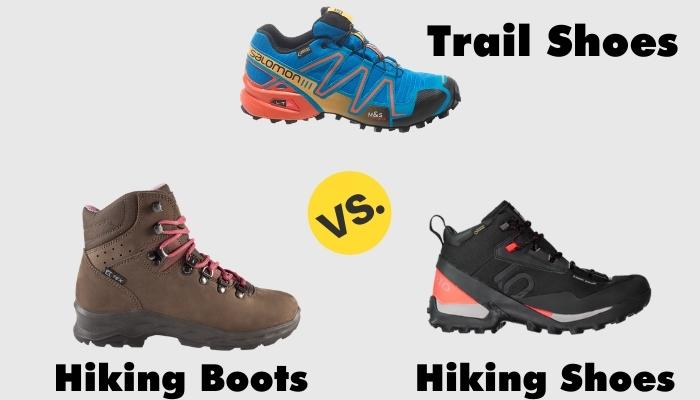You wouldn’t wear high heels at the worksite or work boots on the fashion runway, right? Right, of course not, because they just aren’t the right type of footwear for the occasion. While the gulf between high-heeled stilettos and a pair of Doc Martens may be stark and easy to comprehend, it’s precisely because hiking boots, hiking shoes, and trail running shoes seem ostensibly interchangeable that you need to educate yourself before choosing which type of outdoor footwear is right for you, because they are indeed distinct.
In the simplest possible terms, you need hiking boots for long treks (think multi-day) where you will be toting a decent amount of gear weight over varying ground conditions.
You need hiking shoes when you will have some gear on your back, you anticipate a decent many miles logged, and you expect decently managed trails ahead to be taken at a walking pace.
And you need trail running shoes when you will have little to no gear weight on your back, you need to move fast, and you want maximum traction with minimal weight.
But as your footwear is arguably the most important outdoor gear you’ll use, it being your primary connection to the natural world through which you move, of course, we’ll go deeper than that. And we’ll start with hiking boots.
Hiking boots 101

If you are unsure whether you need hiking boots vs. hiking shoes vs. trail runners, just get yourself a decent pair of hiking boots. The support, warmth, water-resistance, and long working life of a good hiking boot makes it the best choice for the amateur outdoorsman or outdoorswoman who doesn’t need a more specific type of backwoods footwear.
Good hiking boots should last you more than 1,000 miles of use on the trail, so for many more casual hikers or campers, these are the only outdoor footwear you’ll need for many years. And a good pair of hiking boots can also double as work boots.
Full-grain leather hiking boots will offer you excellent waterproofing, the best durability, and the most comfort, but they also tend to be the most expensive and heaviest type of hiking boot. An option that uses some (or all) synthetic materials can be a fine choice and can also be more breathable, excellent for hotter climates.
The benefits of hiking boots
Biking boots have a high collar that can help you out in myriad ways when you’re out on the trail. First, when laced snugly, they help support your ankle and prevent an injury even if you take a bad step that threatens to roll your foot. That raised collar also helps to keep things away from your foot, namely snow, rain, rocks, insects, thorns, and more. And finally, a boot with an elevated collar will keep your foot better insulated than a lower rise shoe.
Hiking boots also tend to have thicker, more absorptive soles and footbeds than trail shoes or hiking shoes, so your foot will be better protected against damage or discomfort caused by hours of trudging over hard rocks, roots, brambles, and so on. For long treks in varied terrain, the hiking boot is a great choice. These thicker soles and added support also help mitigate the effects of carrying a heavy pack, so for longer or shorter treks alike when you are toting lots of gear weight, hiking boots are wise.
Then there is the fact that a good pair of hiking boots can keep your feet warmer and drier than the other types of shoes, even when you are trekking through snow, crossing streams, or dealing with downpours.
The hiking boot cons to consider
Hiking boots are rarely comfortable – or at least nearly as comfortable as they need to be to help you log scores of miles in challenging conditions – when you first put them on. Almost any hiking boot will require a break-in period, so you need to purchase them well in advance of a major expedition and spend the time to break them in properly.
Boots are also usually much heavier than hiking shoes and certainly heavier than any trail runners worth a second’s consideration, so they can tend to weigh and slow you down – this is a necessary sacrifice for the conditions you’ll face in many locations, but still worth noting if you are on the fence as to what gear you need.
Finally, a good pair of hiking boots is usually going to cost much more than a good pair of hiking shoes or trail running shoes, so know your budget and make sure your needs merit the spend before you commit to buying hiking boots.
Hiking shoes 101

For middle-distance hikers – people doing a few dozen miles in a matter of a few days, in other words, not those running 20 miles in one day or hiking a hundred miles in one week – hiking shoes are a great choice. They have relatively thick soles and good support underfoot, so if you have some gear weight and/or you expect to trek over hard-packed or rock terrain, they are a fine choice.
Decent hiking shoes should last 800 or more miles, making them a decent investment for the semi-casual hiker. And except in very loose terrain where it’s easy for your feet to slip out or on very steep climbs when you need all the ankle support you can get, hiking shoes are a great choice for hiking – their name does not try to deceive!
The benefits of hiking shoes
As noted, hiking shoes have the underfoot support needed to absorb the impacts heightened by gear weight and/or by harsh mountain terrain. That support will also be welcome on milder terrain that you encounter for many miles on end.
Because they tend to be made with uppers fashioned from tough synthetic or leather materials, trail shoes easily protect your foot from pokes, bumps, scrapes, and so on. Most are also relatively waterproof, keeping your foot dry in light rain, dewy fields, or even as you cross smaller streams.
Finally, hiking shoes have many of the benefits of hiking boots without the weight, and when you’re trekking for long distances, especially at higher altitudes, every ounce starts to matter.
The cons of hiking shoes
A hiking shoe’s low collar means that in heavy rains, snows, or when you step into a deeper stream or puddle, your shoe will quickly be inundated. And hiking shoes tend to dry out much more slowly than trail shoes, which are designed for maximum breathability and moisture release. So if you’re headed to a wet climate, you might not want to head there with hiking shoes.
While notably lighter than most hiking boots, most hiking shoes are notably heavier than any good trail runner, so don’t try to hedge your bets and get the best of both worlds if what you really do is run. While it’s probably OK to jog for a while in your hiking shoes, they are hardly made for speed, and that goes for overall construction as well as the lug pattern on the soles.
Trail running shoes 101

Trail runners are made for speed, thus they are lightweight, have aggressive tread patterns on their soles that offer excellent traction and support, and they are breathable and moisture-wicking, helping to keep your feet dry even when you are sweating your way across miles and miles. Some trail runners weigh only 10 or 11 ounces per shoe and are superb for well-maintained trails; others are a bit heftier and can be used much like hiking shoes provided you will be carrying minimal weight.
Used heavily, a pair of trail shoes will not last longer than 500 miles before the support gives out, so do plan to swap out your trail shoes often if you are lucky enough to wear them often enough to break them down.
The benefits of trail runners
Trail running shoes have treads designed to do two things: keep you moving forward and keep you on your feet. The often deep, wide-spaced lugs approximate the function of an off-road vehicle’s tires, biting into even rough terrain from rock, sand, mud, or snow, so you can keep your footing even when the ground underfoot is rough.
They are also usually highly breathable, releasing heat and moisture to keep your feet dry even as you sweat and to dry quickly enough after an encounter with a puddle or rainstorm. And most trail runners are so light that you will hardly notice them on and so comfortable that there is little to no break-in period.
Another major benefit of trail running shoes vs. hiking shoes (and of course over hiking boots) is the fact that they can be comfortably worn off-trail. You can walk or run in trail running shoes on pavement just as you would in regular running shoes – they may add a few ounces compared to running shoes, but they are perfectly safe for use as running sneakers.
The cons of trail running shoes
Trail runners just don’t last as well as hiking boots or hiking shoes; they will break down hundreds of miles before their counterparts, and that will seem to come even faster as you will usually wear them over even longer distances than your hiking shoes or boots.
Most trail running shoes also offer much less waterproofing than hiking boots or shoes, so while they can dry quickly, they will often allow water to soak your feet even in moderate rain. If you have chosen to use them as your footwear on a long hike, especially in cold weather, a soaked shoe is far from ideal.
Always put safety first when choosing the right footwear for a backwoods outing; the fun will follow when your kit is properly assembled.

Leave a Reply